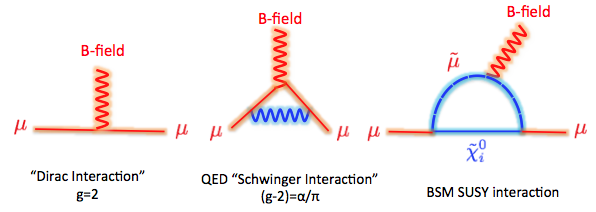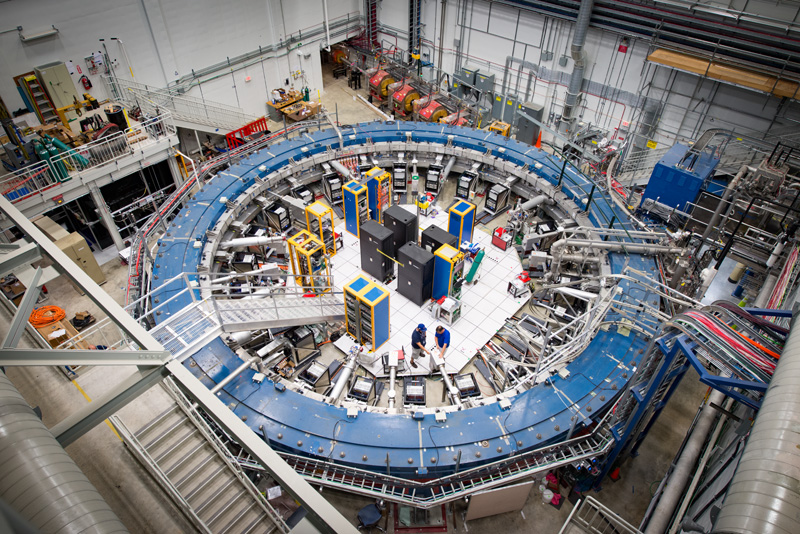A. Keshavarzi, M. Lancaster, G. Sweetmore

The simplest magnetic interaction of a charged particle with a B-field is described by the Dirac equation where the magnetic moment of a charged particle of mass m is defined as gsQe/2m where s is the particle's spin and Qe its charge. In the Dirac theory g is exactly two. However interactions involving virtual particles modify this value of g by a small amount (0.1%) and a precise measurement of (g-2) thus gives information about these virtual particles. A comparison of the measured value with the theory incorporating all known particles and interactions can thus indicate whether there are new particles such as those predicted by models of physics beyond the Standard Model.
The simplest higher order interaction, the "QED Schwinger interaction", modifies g-2 by exactly α/π where α is the EM fine structure constant (1/137.04). New unknown particle contribute to the (g-2) proportionally to (ml/M)2 where M is the mass of the new particle and ml the mass of the charged lepton.
The measurement of the electron's g-2 is the most precisely determined quantity in physics. It has recently been measured to 3 parts in 1013 and its value calculated in QED from a summation of 12,672 Feynman diagrams ! However despite these amazing experimental and theoretical feats, the (ml/M) 2 contribution from new particles is only discernible for small values of M (i.e. M < 100 MeV) and presently the measured and predicted values are in good agreement. In contrast a measurement of the g-2 of the muon, whose mass is 220 times that of the electron, has a sensitivity to new particles with masses in the range 10 MeV to 1000 GeV and thus at the upper end is probing a similar mass region to the LHC experiments but in a very different way. The muon g-2 measurement can also probe low mass physics below the sensitivity of the LHC.
The current world's best determination of the muon g-2 has been measured by the Fermilab (FNAL) Muon g-2 experiment. It is the most precise measurement ever made at a particle accelerator. This measurement together with a previous measurement at Brookhaven National Laboratory (BNL) differs from the SM prediction by 4.2 standard deviations and this received significant media interest. and the publications together now have over 5,000 citations. The analysis of data accumulated after 2018 from the FNAL experiment and refinements in the SM prediction will enable us to confirm or not whether we are indeed observing new physics not encompassed in the SM and the experiment hopes to achieve an ultimate precision of 0.14 parts per million. By comparison the Z mass was determined by the LEP experiments to a precision of 20 parts per million. It is possible to make this new measurement with such a precision by exploiting the muon beamline at Fermilab and re-using the Brookhaven storage ring. This 14m diameter, 17 tonne storage ring provides a uniform magnetic field to better than 0.1 parts per million and is a unique apparatus. It was transported 3000 miles from Brookhaven (Long Island) to Fermilab (Chicago) via road and barge in 2012.

The magnetic moment is determined by injecting polarised muons of a very specific energy (3.1 GeV) into a storage ring that has a uniform 1.45 T magnetic field and counting the number of decay positrons above 1.9 GeV in 24 calorimeters around the storage ring as a function of time. The direction of the higher energy decay positrons is strongly correlated with the direction of the muon spin which precesses around the magnetic field at a rate determined by (g-2). To achieve the 0.14 parts per million in statistical precision, 200 billion muon decays must be measured. The muons are created from pion decays which in turn come from an 8 GeV proton beam striking a lithium target.